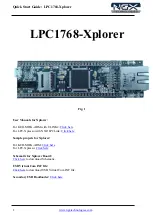
http://www.tyan.com
113
RAID (Redundant Array of Independent Disks):
a way for the same data to be
stored in different places on many hard drives. By using this method, the data is
stored redundantly and multiple hard drives will appear as a single drive to the
operating system. RAID level 0 is known as striping, where data is striped (or
overlapped) across multiple hard drives, but offers no fault-tolerance. RAID level 1
is known as mirroring, which stores the data within at least two hard drives, but
does not stripe. RAID level 1 also allows for faster access time and fault-tolerance,
since either hard drive can be read at the same time. RAID level 0+1 is striping and
mirroring, providing fault-tolerance, striping, and faster access all at the same time.
RAIDIOS:
RAID I/O Steering (Intel)
RAM (Random Access Memory):
technically refers to a type of memory where
any byte can be accessed without touching the adjacent data and is often referred
to the system’s main memory. This memory is available to any program running on
the computer.
ROM (Read-Only Memory):
a storage chip which contains the BIOS; the basic
instructions required to boot the computer and start up the operating system.
SDRAM (Synchronous Dynamic RAM):
called as such because it can keep two
sets of memory addresses open simultaneously. By transferring data alternately
from one set of addresses and then the other, SDRAM cuts down on the delays
associated with non-synchronous RAM, which must close one address bank before
opening the next.
Serial port:
called as such because it transmits the eight bits of a byte of data
along one wire, and receives data on another single wire (that is, the data is
transmitted in serial form, one bit after another).
SCSI Interrupt Steering Logic (SISL):
Architecture that allows a RAID controller,
such as AcceleRAID 150, 200 or 250, to implement RAID on a system board-
embedded SCSI bus or a set of SCSI busses. SISL: SCSI Interrupt Steering Logic
(LSI) (only on LSI SCSI boards)
Sleep/Suspend mode:
in this mode, all devices except the CPU shut down.
SDRAM (Static RAM):
unlike DRAM, this type of RAM does not need to be
refreshed in order to prevent data loss. Thus, it is faster and more expensive.
SLI (Scalable Link Interface)
: NVIDIA SLI
technology
links two
graphics cards
together to provide scalability and increased performance. NVIDIA SLI takes
advantage of the increased
bandwidth
of the
PCI Express
bus architecture, and
features
hardware
and
software
innovations within NVIDIA
GPU
s (graphics
processing units) and NVIDIA MCPs (media and
communications
processors).
Depending on the
application
, NVIDIA SLI can deliver as much as two times the
performance of a single GPU configuration.
Содержание S7066
Страница 2: ...http www tyan com 2...
Страница 10: ...http www tyan com 10...
Страница 13: ...http www tyan com 13 2 2 Block Diagram S7066 Block Diagram...
Страница 14: ...http www tyan com 14 2 3 Mainboard Mechnical Drawing...
Страница 17: ...http www tyan com 17 J64 J20 J66 J45 J25 J63 J65 J19 J26 J39 J1...
Страница 19: ...http www tyan com 19 J14 J44 J4 J34 J29...
Страница 21: ...http www tyan com 21 J30 SATA1 SATA0 ID LED J28 J24 IDLED BTN...
Страница 23: ...http www tyan com 23 J3 J69 J38 J2 J70...
Страница 26: ...http www tyan com 26 J33 J68 J75 2PHD 1...
Страница 52: ...http www tyan com 52 Current Status Information Read only...
Страница 55: ...http www tyan com 55 3 3 3 1 Socket 0 1 CPU Information Read only...
Страница 65: ...http www tyan com 65...
Страница 66: ...http www tyan com 66 3 3 10 Super IO Configuration Super IO Chip Read only...
Страница 77: ...http www tyan com 77 MMCFG Base Select the MMCFG BASE Values 0x80000000 0xA0000000 0xC0000000...
Страница 80: ...http www tyan com 80 3 4 1 3 DIMM Information Submenu Read only...
Страница 92: ...http www tyan com 92 3 8 Event Logs...
Страница 104: ...http www tyan com 104 BIOS Temp Sensor Name Explanation...
Страница 106: ...http www tyan com 106 NOTE...
Страница 108: ...http www tyan com 108 NOTE...



































